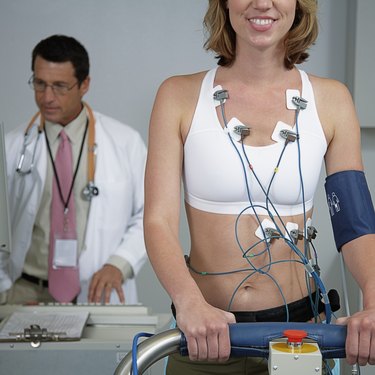
Your heart rate slows down when you stop exercising. Your pulse two minutes after exercise is what is called your "recovery heart rate," and that rate will go down as you become more fit. The actual numbers vary because everyone's heart rate varies--even between similar people at similar fitness levels. In some people, the heart rate remains elevated after exercise, and electrical pulses from the heart are irregular. This is often a sign of potential health problems, according to the Harvard Medical School Family Health Guide.
Recovery Time
Video of the Day
The heart rate of a typical individual will return to resting levels shortly after light or moderate exercise.The heart rates of athletes--particularly endurance-trained and strength-trained athletes--will return to normal after exercise faster than nonathletes.
Video of the Day
Slow Recovery
A healthy person should see his heart rate decline by 15 to 20 beats per minute in the first minute after stopping exercise. Your "recovery heart rate"--the pulse you register two minutes after you stop exercising--is a measure of how fit you are. Say you run for 30 minutes at an average heart rate of 155 beats per minute and your heart rate two minutes after finishing is 95 beats per minute. As you become more fit, your heart rate will decrease faster after that 30-minute run, and your recovery heart rate will be lower at the two-minute mark. In healthy individuals, an effective program and healthy diet can also lower significantly resting heart rate.
Stress Test
Doctors use stress tests to examine how well a heart functions during exercise. A stress test uses a blood pressure cuff and an electrocardiograph to measure how exercise on a treadmill or exercise bike affects your blood pressure, heart rate and the heart's electrical activity. The test can reveal conditions--such as clogged arteries--that don't show up when the person's heart rate is normal. According to the Journal of Exercise Physiology, a slow return to a normal heart rate could mean the person has a great risk of developing diabetes, abdominal obesity, high cholesterol and other cardiovascular risks.
Abnormal Pulse
In recent years, doctors have started examining what happens to a patient's heart as it returns to its normal pulse rate after a stress test. While uncommon rhythms during exercise don't seem to be cause for concern, abnormal pulses in the heart ventricles that occur only after exercise can indicate a higher risk of imminent death, the Family Health Guide says.
Death Studies
In one study, 11 percent of the people who had this problem died within five years while only 5 percent of those who didn't show this characteristic died. In another study, those whose heart rates took longer than normal to recover were four times more likely to have died over the next three years, the Family Medical Guide reported.
Treatment
If your doctor notices an irregular rhythm during the 5- to 10-minute cool-down period after a stress test, she may take more proactive actions to control the factors that can trigger heart attack or stroke in the patient, such as high blood pressure, high cholesterol, high blood sugar, obesity and smoking. Your doctor may also order an echocardiogram to more closely examine your heart in action.
Exercise Helps
People who show signs of future heart problems may still be advised by their doctor to exercise. According to the University of New Mexico, exercise helps control and prevent high blood pressure, diabetes and other health problems. But most doctors will want to confer with their patients before a patient with potential heart problems begins or continues an exercise program.